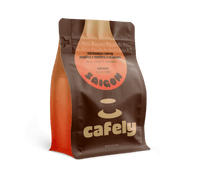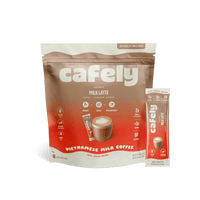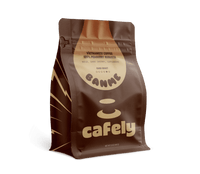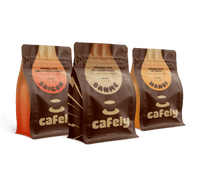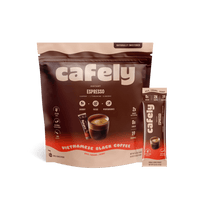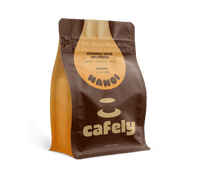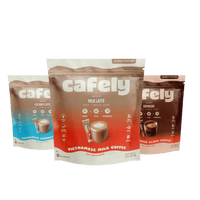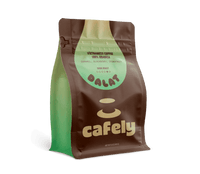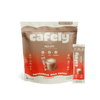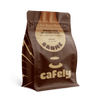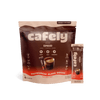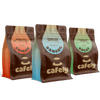Nothing ruins a morning faster than that first sip of sour, disappointing coffee — especially when you've splurged on premium beans.
But before you toss those expensive grounds in the trash, know this: sour coffee is almost always fixable, and the solution is simpler than you think.
The culprit behind that puckering taste?
It's usually one of two things:
- Stale beans that have lost their flavor compounds.
- Under-extraction during brewing, where you're only getting the acidic compounds instead of the full, balanced flavor profile your beans are capable of delivering.
The good news?
You can transform your next cup from sour disappointment to café-quality perfection with just a few tweaks to your brewing method or storage habits.
Here's exactly how to diagnose what's going wrong and fix it for good.
Why Does My Coffee Taste Sour?

Your sour coffee comes down to two main culprits: stale beans and under-extraction during brewing. Here's what's happening in your cup.
Stale Coffee Beans: Flavor Lost to Time
Coffee's flavor compounds are volatile—they break down when exposed to air, heat, and light. Over time, your beans lose their complex flavors and develop that flat, dull taste that no amount of cream can fix.
Under-Extraction: The More Common Culprit
Under-extraction happens when you haven't dissolved enough flavor compounds from your grounds. Instead of getting the full spectrum of flavors, you're only extracting the most soluble compounds—the acidic, sour-tasting ones.
What causes under-extraction:
- Grinding too coarse - Larger grounds have less surface area for water contact
- Water too cool - Lower temperatures extract fewer compounds
- Brewing time too short - Not enough contact time for full extraction
The result? That sharp, astringent sourness that makes your coffee taste like cranberry juice.
The good news: both problems have straightforward fixes.
How to Fix Stale Bean Problems
Start with fresh beans — look for a roast date within the last two weeks on specialty coffee packaging.
Once you've got them home, proper storage makes all the difference. Keep your beans in an airtight, opaque container in a cool location to shield them from the four flavor killers: air, heat, light, and moisture.
Planning to store coffee for months? Vacuum-pack and freeze your beans to lock in that fresh flavor.
How to Fix Under-Extraction
The quickest fix is grinding finer — adjust your grinder one or two increments to increase surface area and boost extraction.
Water temperature matters too, so brew with water around 200°F (93°C) for optimal results.
Finally, give your coffee more time by extending the brewing process, allowing the water and coffee to interact longer and dissolve more of those delicious flavor compounds.
Other Factors Affecting Your Coffee’s Flavor
The simplest way to prevent your coffee from having sour flavors is to regularly clean your equipment.
From the smallest spoon to the biggest espresso machine, all coffee tools and implements can build up small amounts of grounds. These grounds, over time, will become stale and take on a sour, unpleasant flavor. If they end up mixed in with your fresh coffee grounds, you can get a cup that tastes unpleasant overall.
Secondly, you may experience some sourness in your coffee if you’re using low-quality water. Most people’s tap water is perfectly fine for brewing coffee, but water with a high volume of minerals can impact the taste of coffee.
If your water is a problem, use a simple water filter before brewing. Water filters are typically quite affordable, and you may already have one. Even the cheapest water filter may vastly improve the flavor of your coffee.
How to Pick the Best Coffees to Avoid Sour Flavors

Since a lot of different factors impact the sourness of a given coffee, it might seem daunting to try to narrow down which coffee is best for you. However, there are some key factors to bear in mind that can be a great help.
Origin Matters
Firstly, think about the coffee farm elevation. Coffee grown in higher altitudes, like in mountainous regions of the Vietnamese highlands, makes the coffee cherries ripen a bit slower because of the cool mountain air.
This leads to the coffee beans developing more natural sugars over time, producing sweeter coffee when roasted, ground, and brewed.
Unfortunately, this can also increase the sourness of the coffee. Increased elevation typically means that the coffee beans naturally contain more acid, which can lead to a greater acidity in the final coffee.
To counteract this, it’s common to roast more highly acidic beans to a darker roast level. This will enhance the natural sweetness and evaporate some of the chlorogenic acids, leading to a balanced final flavor.
Roast Levels & Flavor Profiles
The best roast level to reduce the sourness of coffee is a dark roast.
Lighter roasts retain lots of plant flavors from the green coffee bean. This is why the tasting notes for these lighter roasts often center around nut or citrus flavors. That’s the natural, plant-like flavor profile of the coffee.
Darker roasts, however, have a more developed flavor. Through a process called the Maillard reaction, the sugars within the coffee are caramelized over time. This eventually leads to a rich, bittersweet flavor in the best dark roasts.
Robusta vs. Arabica
Robusta and arabica beans are the two most popular coffee bean species, and they have quite different flavor profiles. Robusta beans have a higher caffeine content, while arabica beans have more acids, fat, and sugar, leading to a more delicate, complex flavor profile.
Acidity is most responsible for the sour flavor in your coffee. So, to reduce the acidity in your beans and your final cup, look for dark roast robusta beans. The end product will give you an earthy, bittersweet flavor with minimal acidity and sourness.
High-Quality Coffee
To get the best-tasting coffee, there are a few core things to keep an eye on. Higher quality in your coffee means greater flavor in your brews.
- Organic — Organic coffee comes from farming practices stipulate that no human-made pesticides and herbicides are used on the fields. In turn, this allows the plants to grow more naturally and slowly, leading to greater flavor development.
- Mold-Free – Some crops can experience mold growth during storage and shipping. To avoid mold and mycotoxins, look for certified mold-free beans.
- No Added Sugar — Adding sugar to beans or grounds is sometimes done to mask a bad roast or a bad crop. To get good-quality beans, look for those that have no added sugar.
- Freshly Roasted — Coffee will, over time, lose its flavor and go stale. To get the most flavor out of your beans, look for coffee that has been roasted in the last two weeks.
FAQs: Why Does My Coffee Taste Sour?
Now that we’ve covered what can make coffee taste sour, here are some FAQs to break down some common queries.
1. How Do You Fix the Sour Taste in Coffee?
The simplest ways to fix sour-tasting coffee are to make sure you’re using fresh coffee beans and increase extraction during brewing. You can increase extraction by grinding your coffee more finely, increasing the brewing time, or increasing the temperature of the brewing water.
2. Why Does Coffee Suddenly Taste Sour to Me?
If your coffee’s sour, it’s quite likely that it’s a little under-extracted. If this happens suddenly, consider if you’ve just switched to a new coffee and you’re not used to brewing with it yet. By extracting more during brewing, you should be able to resolve any sour flavors.
3. Is It Okay to Drink Sour Coffee?
While there are likely some exceptions to this rule, sour coffee is typically safe to drink. Coffee can become sour when it’s stale, but while stale coffee has reduced flavor, it’s not necessarily unsafe to drink. Be concerned if your coffee beans have visible signs of mold, such as a white powder.
4. How Do You Get Rid of Acidic Coffee Taste?

Coffee usually tastes acidic because it’s been under-extracted. To counteract this in your next cup, try grinding the coffee a bit finer — the brew should be more flavorsome and balanced. If you’re looking to make a cup of coffee taste a little smoother, try adding a dot of milk or cream to balance out the acidity.
5. Why Does My Coffee Taste Sour and Bitter?
It’s quite rare for coffee to taste both sour and bitter. Under-extracted coffee is typically sour, while over-extracted coffee is typically bitter. If your cup tastes both sour and bitter, it may be that you’re using over-extracting from stale coffee, which naturally develops a sour taste over time.
6. Is Coffee Acidic for the Stomach?
Yes, coffee is acidic. This acid can make some people feel unwell, particularly if they have a condition such as acid reflux. To decrease the amount of acidity in coffee, consider trying cold brew, which has a very smooth, sweet flavor.
7. Which Coffee Is Not Sour?
Any well-brewed coffee shouldn’t be sour. However, the coffees least likely to taste sour are dark roasts. Chlorogenic acids in green coffee beans are principally responsible for a sour, acidic flavor. These acids evaporate during roasting, so beans that have been roasted for a longer time can have a less profound acidity.
8. How Can I Tell if Coffee Is Off?
Coffee goes from being fresh to stale, then on to properly spoiled. Stale coffee typically has a very flat smell and taste and may be a little musty. The best sign of spoiled coffee beans is to check for mold, which is most commonly present in coffee beans as a white powder.
9. Does Sour Mean Acidic?
Sour certainly can mean acidic. Generally, a sour flavor in food or drink is there because of organic acids from the ingredients. This is the case with coffee, too — a sour flavor may be present due to the chlorogenic acids in coffee beans.
10. Does Milk Make Coffee Less Sour?
Milk doesn’t alter the makeup of coffee to decrease the acidity, but it can mask the sour flavor. Since milk and cream have smooth, rich flavors, they can be a good foil to a harsh sour flavor in coffee. They may also help by diluting the drink, making the acid less intense overall.
